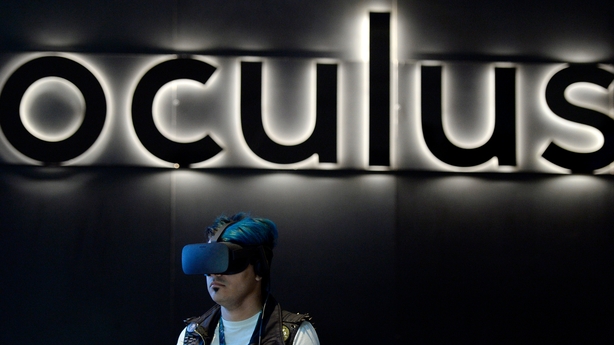The concept of lots of people pooling relatively small amounts of money to create a large fund – for a person, charity or business – is nothing new.
But being able to build that fund in real time, on a global basis, is a relatively new phenomenon.
Despite that, crowd-funding has become huge business.
Exact figures are hard to find, but there are estimations of between $11 billion and $17 billion of crowd-funding transactions made in 2022 alone.
That figure is predicted to rise to as much as $40 billion by 2028.
They’re not always about charity though, are they?
We need your consent to load this rte-player contentWe use rte-player to manage extra content that can set cookies on your device and collect data about your activity. Please review their details and accept them to load the content.Manage Preferences
No. People are perhaps most familiar with fundraisers on platforms like GoFundMe – but a crowd-funding campaign can really be for anything.
Kickstarter and Indigogo, for example, are well known as places that people try to get funding for a new product, or even film or TV series.
Generally they show off a proof concept – or even a prototype – and ask people to give money to make that a reality.
Usually they offer backers something in return – like a copy of the product, or early access to the content they make.
Essentially it’s a way of getting people to buy something advance – with the added advantage of proving there’s a market for what they’re seeking to make.
Meanwhile a lot of creatives use platforms like Patreon to help fund their work.
As the name suggests, it’s a modern version of the old 'patron’ system – allowing people to commit funds to an artist they like so they can keep making things.
In return, they might get early or exclusive access to something they make.
How big can crowd-funding campaigns get?

They can raise incredible sums of money.
With GoFundMe, for example, its biggest campaign to date has been America’s Food Fund.
That was set up by Leonardo DiCaprio and Lauren Powell Jobs – the widow of Steve Jobs – to raise money to feed disadvantaged people in the US.
So far it’s raised more than $45m through its campaign.
A campaign set up by Mila Kunis and Ashton Kutcher to provide support to Ukraine has so far raised $37m on GoFundMe.
Meanwhile more than $24m was raised by the ‘Time’s Up Legal Defense Fund’, to help people who were taking cases relating to alleged assault and discrimination.
And, while we’re not talking multiples of millions – some campaigns are very successful because they far surpass the amount the creator sought to raise.
Back in 2014, Zack ‘Danger’ Brown set up a Kickstarter seeking to raise $10 to fund his making of a potato salad.
In the end he raised more than $55,000 – which he ended up putting towards the creation of a potato salad recipe book.
What about the non-charitable ones?

The biggest one on record relates to an author that very few people would know of.
Brandon Sanderson is an American fantasy and science fiction author who has written a wide array of books and graphic novels.
Some may know him as the man who was hand-picked to finish the hugely popular Wheel of Time series – which is now being made into a TV series on Amazon Prime.
Back in March 2022 he raised $41.7m to fund the release of four new books.
He had 185,341 backers – which means they would have offered an average of $225 each to make the books happen.
Other successful Kickstarters include the Pebble watch – an early smartwatch made by a company that was ultimately acquired by Google.
The Oculus virtual reality headset also started life on Kickstarter.
That company was eventually bought up by Facebook, or Meta as it’s now known, and forms the foundation of their plans for a virtual reality ‘metaverse’.
These campaigns aren’t guaranteed to be well-received, though, are they?

No – absolutely not.
In most cases, campaigns get little or no interest – especially the business-focused ones, but also the more charitable ones too.
Sometimes, they spark a bit of backlash, too.
Often times it’s because you have a celebrity behind it – leading to accusations of them being so-called ‘rich beggars’.
The actress Alyssa Milano recently faced criticism after she posted a fundraiser for her son’s baseball team – which was seeking to raise $10,000 to cover travel costs, kits and player subs.
Some people pointed out that she’s not exactly hard up herself – and it was a bit much to be asking her fans and followers to fund her child’s activities.
It wasn’t helped by the fact that she then posted a picture of herself and her son having some ‘bonding’ time at the Super Bowl – which couldn’t have come cheap.
Despite that her GoFundMe campaign raised well in excess of the $10,000 she was looking for – so it worked.
But there are also some high-profile cases of deceit.
The ‘We Build The Wall’ campaign was set up in late 2018 and purported to be an attempt to fund the building of a border wall between the US and Mexico.
It went on to raise more than $25m through GoFundMe – but it all fell apart when a number of people, including Steve Bannon, were charged with conspiracy to commit mail fraud and money laundering because of their plan to use some of the fund for personal use.
Two of those charged later pled guilty.
Steve Bannon was pardoned by US President Donald Trump before he left office, so he didn’t face the federal charge.
GoFundMe also refunded most of what was donated – unless people opted to transfer their donations to a separate non-profit set up by the campaign.
How do people know their money is going where they say it’s supposed to go?
In the case of GoFundMe, it says it has a team operating seven days a week, and in different time zones to weed out any dodgy campaigns.
They also require the people behind campaigns to verify their identity and bank details before they get access to any money.
So, GoFundMe says, most attempts at fraud are spotted in plenty of time – but it also refunds donations when something is missed.
But like anything that involves putting your hand in your pocket, it’s always wise to show a degree of restraint and caution before spending money.
If it’s a fundraiser for a particular person, for example, you might check to see if they or their close family are sharing it on their own social media accounts.
If they’re not, that would be a big red flag.
When it comes to the non-profit stuff, like on Kickstarter, investing is a good bit riskier.
The money isn’t taken off you until a campaign ends and the funding target is met.
If that’s achieved your money goes to the creator – and you just have to hope that they follow through.
Kickstarter doesn’t accept any responsibility if a project fails to live up to the promise, or if it takes longer than expected for them to deliver on what they promoted in the first place.
So it’s a real ‘buyer’ or ‘would-be buyer’ beware situation.
Does all of the money someone donates go to the person?

In short, no.
In the case of GoFundMe, there’s a 2.9% transaction fee, plus 25c deducted from every donation made to a personal fundraiser.
So if you donate €10, the recipient gets €9.46 (minus 29 cent – or 2.9% - and 25c)
The deduction is slightly less if you’re donating to a charity via GoFundMe.
For the likes of Kickstarter, the fees taken away are quite a bit bigger.
It takes 5% of the total funds raised – while there’s also a payment processing fee of 3%, plus 20c.
Though if you don’t get fully funded, the full amount donated is refunded and no fee is charged.
What about tax – do people have to give some of what they get to Revenue?
Possibly – it all depends.
When it comes to charitable giving, in theory that money could be subject to capital acquisitions tax – but in practice very few people would need to worry about it.
There’s an annual CAT exemption of €3,000 per person per year – so as long as each person is giving you less than that each year, you won’t have to pay capital acquisitions tax on it.
And given that most of the donations made on these sites would be small – almost certainly under €100, you’re probably safe enough.
But if the money is being given to fund the creation of something, like a product, or a film, and you’re getting a copy of it in return for your donation – then that donation could be considered income. That means it could be liable to pay income tax on it.
Revenue said these things can be quite complicated so it’s best for people to seek independent, professional advice – or go directly to them – to ensure everything is being done correctly.
Does anyone think crowd-funding is a bad thing?

Celebrity-backed crowd-funding often receives criticism for a number of reasons.
Some feel that well-known actors, writers or directors should not be using platforms like Kickstarter to get projects made, as they already have the access and influence they need to get their ideas picked up the traditional way.
Using crowd-funding, critics argue, simply takes focus away from those who are trying to get started in the industry.
People also feel that the rich should not be asking those with less to fund their causes.
Leonard DiCaprio and Lauren Powell Jobs donated $5m to their American Food Fund campaign, but some argue they did not need to seek the public’s support at all.
DiCaprio reportedly made around $40m from Killers of the Flower Moon alone.
Forbes estimates that Lauren Powell Jobs and her family are worth $13.5 billion, thanks in large part to the Apple and Disney shares she inherited after Steve Jobs died.
But perhaps the biggest criticism that’s levied at these charitable platforms – one that isn’t necessarily their fault – is that they’ve become a de facto social safety net; especially in the US.
It’s now common to see people fundraising to cover the cost of what should be considered routine surgery – or for help with their medical bills.
Many argue that the ability to crowd-fund gives a kind of virtuous sheen to what is a political failing.
For the non-charitable campaigns, the fact that backers get a limited return on their investment is also a source of criticism.
Companies like Pebble and Oculus arguably couldn’t have succeeded without thousands of people chipping in to get their prototypes mass-produced – however none of them gained financially when those firms were acquired for multi-million dollar sums.







